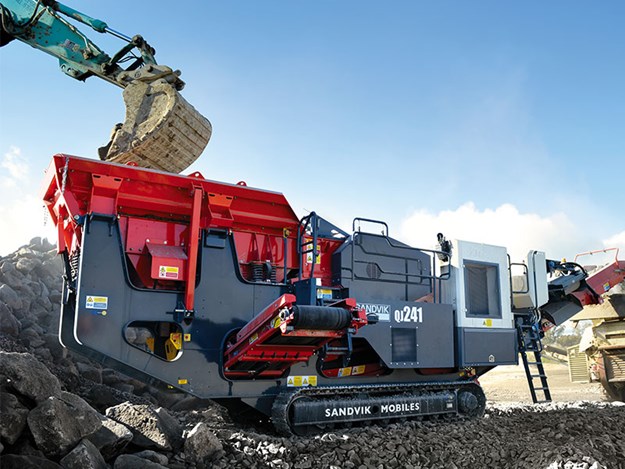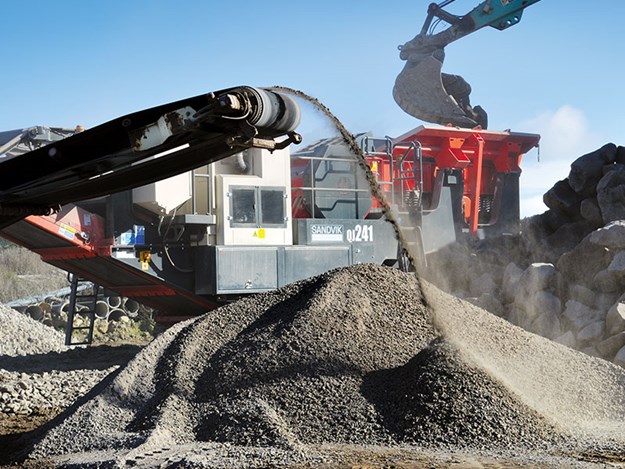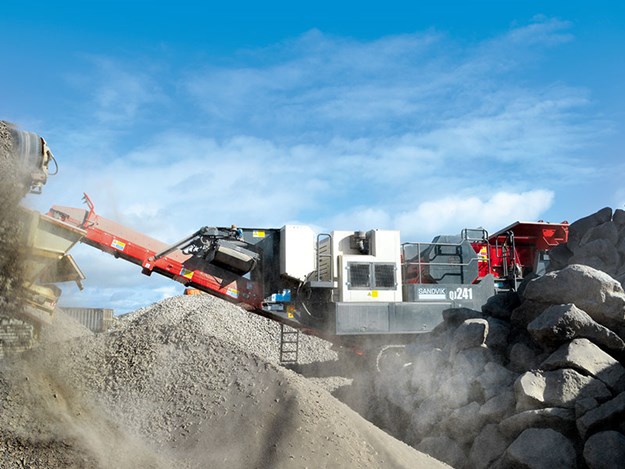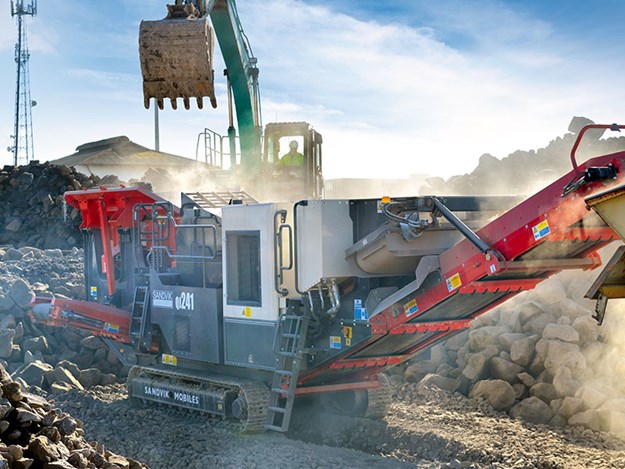Cover story: Sandvik screening and crushing
The robust, technologically advanced Sandvik screening and crushing range has established itself as a ‘go-to’ brand for a multitude of operators throughout NZ
Swedish engineered Sandvik mobile screening and crushing equipment enjoys a global reputation as a true heavyweight in the field.
Taking a deeper dive into what makes these machines so dependable, however, brings another fact to the surface: there’s a lot of technology involved in something as ‘simple’ as crushing aggregate.
Porter Equipment Sandvik and BOMAG product specialist, Johan Hanekom, says it’s impressive how many features across the wider Sandvik range are offered as standard fitment. Whatever the application and environment, the manufacturer’s jaw and impact crushers deliver a suite of benefits over the competition that’s hard to beat.
 |
|
Although the smallest in the line-up, the Sandvik QJ241 is probably Sandvik’s most popular variant of tracked jaw crusher
|
"These really are versatile machines that match ability with absolute robustness. They’re designed to be used relentlessly and to give the owner maximum performance," says Johan.
Especially when it comes to recycling material such as concrete, Sandvik jaw and impact crushers offer supreme ruggedness. But they also work to protect their own systems and components, providing peace of mind for the operator.
"Sandvik jaw and impact crushers work to protect themselves, and in order to do this, they have some very clever sensor capabilities onboard as standard," explains Johan.
"The jaw crushers feature a deflector plate at the bottom of the jaw, which bends rebar before it goes on the conveyor belt. Both types of Sandvik crusher also come with overhead magnets as standard in order to remove rebar. As a fail-safe, the machine boasts hydraulic adjustment of the CSS jaw and reverse function that can run the jaw in reverse to relieve any blockages that do occur."
Sandvik jaw crushers also feature level sensors to control material feed rates into the crusher, helping maximise production, while the machine’s hydraulically driven cooling fan provides for increased reliability. An auto-reverse function is also designed to periodically back flush any dust build-up in the radiator.
High-quality output
 |
|
The QJ241 has been designed for small to medium quarry and demolition operations
|
When it comes to choosing a machine that will deliver comprehensive crushing ability, Johan says that bigger isn’t necessarily better.
"The Sandvik QJ241 is probably our most popular variant of tracked jaw crusher, even though technically speaking, it’s the smallest unit in the line-up. But it offers the operator so much flexibility in return, and we have several customers who will bring their QJ241 in onto a temporary site and crush material there and then, rather than having to truck and trailer it back to another yard off-site. The whole recycling process is sped up as a result."
With an operating weight of 34 tonnes, the Sandvik QJ241 tracked mobile jaw crusher has been purposefully designed for small to medium quarry and demolition operations.
This ‘go-to’ machine meets Stage 3B/Tier 4i legislation optional Tier 4 Final and boasts a variety of component upgrades, all designed to make operation more straightforward while improving material throughput and reliability.
These include a Danfoss hydraulic control system for improved operating efficiency, the ability to hydraulically raise and lower the main conveyor to give increased clearance, a tunnel arrangement to reduce catchment points in recycled materials, as well as an extended conveyor for greater discharge height. Born from operating environments that can offer up harsh temperatures just like New Zealand, the Swedish manufacturer uses steel pipework extensively throughout the machine in order to give superior heat dissipation and to provide maintenance-free sealing.
The mobile crusher units also feature an automatic central lubrication system to reduce maintenance time; in fact, when Porter Equipment’s field teams service these machines as part of scheduled after-sales service packages, all major service points can be safely accessed from ground level or via wide pedestrian platforms. For everyday use, all major controls—including the logically arranged colour operator screen—can be utilised at ground level for extra safety.
 |
|
The QJ241 boasts a variety of component upgrades, all designed to make operation straightforward
|
"Porter Equipment really prides itself on having service technicians that know these machines inside and out, which is part of the peace of mind of investing in Sandvik crushing equipment for our customers," adds Johan.
This mix of proven crushing ability matched with well-regarded back-up at a national level extends to Sandvik’s line-up of mobile impact crushers. Johan says the Sandvik QI341 impact crusher is a similarly good example of the wide spread of technical abilities this type of crushing solution offers a material recycling operation.
"A big advantage an impact crusher like the Sandvik QI341 offers operations is its double-deck pre-screen system, which allows fines to be discharged through a three-way split out a hydraulically adjustable side channel or down the main conveyor."
The efficient double-deck pre-screen system offers a large screening area of 1520mm x 980mm, including a 40mm top deck and 20mm underscreen. These work together to maximise material throughput and reduce wear on componentry. Operators have the flexibility of utilising a punch plate top deck, grizzly bar, and screen mesh bottom deck.
Maximum productivity
 |
|
Sandvik’s crushing equipment features several systems that work to clear material blockages or help avoid them altogether
|
Elsewhere within the Sandvik QI341, the company’s patented Prisec crushing box is designed to work as either a primary or secondary crusher simply by adjusting the machine’s curtain shaft positions. Both first and second curtains are fully hydraulically adjustable, meaning impressive reduction ratios can be achieved while crusher blockages can also be minimised.
The ability to hydraulically raise the curtains means the operator can let blockages pass while the crusher remains running, helping keep material moving through the machine. This system also means the operator doesn’t need to physically intervene, creating a much safer unblocking scenario.
Johan says all Sandvik’s main conveyor systems feature belt scrapers, canvas dust covers, and dust suppression spray bars.
"With rebar and other material able to damage the main conveyor belt when exiting the crushing chamber at speed, a fully wear resistant-lined underpan feeder takes the impact of this material and transfers it onto the conveyer at a regulated speed.
"Also, Sandvik’s hydraulic aprons are pressurised, so if the sensor system encounters any rebar or uncrushable material, it will automatically open up to let this material go through and automatically close down the CSS to original once cleared, ensuring through-put down the main conveyor remains consistent.
"It’s consistency that our customers are after at the end of the day," he concludes. "Sandvik’s onboard machine management systems and hard-wearing components all work together to make sure any operation can expect consistent performance from their crusher, which, of course, leads to consistent product quality out the other end.
"And that’s also what we aim to do with Porter Equipment’s back-up support. It doesn’t matter where our customers are in the country or what specific application they’re using their Sandvik for, we want to make sure they receive top-quality service right across the board that’s worthy of the investment they have made in this equipment."
Find new and used loaders for sale in NZ
Keep up to date in the industry by signing up to Deals on Wheels' free newsletter or liking us on Facebook.





.jpg)

.jpg)
.jpg)
.jpg)
-(1).jpg)
.jpg)

